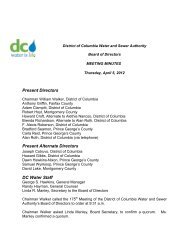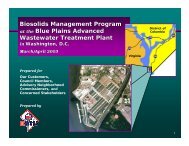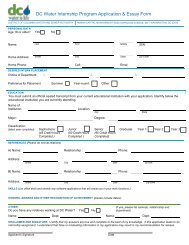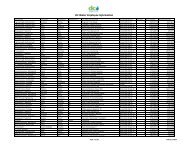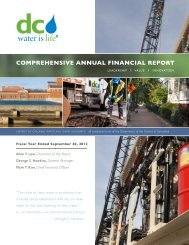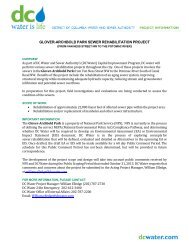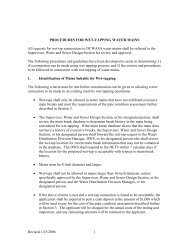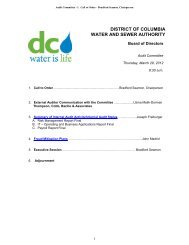Hist and Proj Operating Receipts FY 2011 2 17 2010 - DC Water
Hist and Proj Operating Receipts FY 2011 2 17 2010 - DC Water
Hist and Proj Operating Receipts FY 2011 2 17 2010 - DC Water
Create successful ePaper yourself
Turn your PDF publications into a flip-book with our unique Google optimized e-Paper software.
. Wholesale Capital Payments - Approximately 60 percent of the capacity of <strong>DC</strong> WASA's wastewater treatment facilities are<br />
contractually committed to provide wholesale service to suburban jurisdictions under various contracts. Montgomery <strong>and</strong> Prince<br />
George's Counties (through the Washington Suburban Sanitary Commission (WSSC)), Fairfax County, <strong>and</strong> the Loudoun County<br />
Sanitation Authority pay a proportionate share of capital-related costs equal to their share of contracted capacity at Blue Plains.<br />
. Revenue Bonds/ Commercial Paper - Debt issuance represents 62 percent of funding for the ten-year capital program. A<br />
common ratio used by the rating agencies to measure leverage <strong>and</strong> debt burden is the ratio of debt to net fixed assets (Plant). ln<br />
<strong>FY</strong> 1999, <strong>DC</strong> WASA's debt to Plant ratio was 36 percent, <strong>and</strong>, based on the current capital improvement program, is projected to<br />
increase to 57 percent through <strong>FY</strong> 2018. ln addition, debt service as a percentage of total operating expenditures is 23 lo 44<br />
percent through the ten-year planning period, even with substantial new debt issuance projected during this period.<br />
. PAYGO (lnternal) Financing - The amount transferred from operations to the capital program each year is equal to the amount<br />
remaining in cash reserves after the four month operating <strong>and</strong> maintenance reserve <strong>and</strong> rate stabilization fund goals have been<br />
satisfied. Approximately 2.8 percent of total funding for the <strong>FY</strong> 2009 - 2018 plan is projected to come from PAYGO financing,<br />
which strikes an appropriate balance between maintaining moderate debt levels <strong>and</strong> financing provided by current ratepayers.<br />
PAYGO funds will be used in a manner consistent with our financial policies: 1) to fund items with shorter useful lives where<br />
bond financing is less appropriate, such as capital equipment; <strong>and</strong> 2) to achieve the lowest cost of capital possible, including<br />
using pay-go funds to reduce higher cost debt.<br />
<strong>FY</strong> <strong>2010</strong> & <strong>2011</strong> Debt /ssuance Plans & Debt Seruice Assumptions<br />
Permanent Financing - we successfully issued $300 million of tax-exempt senior lien fixed rate revenue bonds in January 2009. The<br />
proceeds were used to fund new capital projects, refund $50 million tax-exempt commercial paper <strong>and</strong> $14.8 million in taxable paper.<br />
Taxable commercial paper was issued to refund $44 million of the 20078 bonds. Based on current capital spending projections, we<br />
plan to issue commercial paper in the fourth quarter of <strong>FY</strong> <strong>2010</strong> <strong>and</strong> permanent financing in the first quarter of <strong>FY</strong> <strong>2011</strong>. ln order to<br />
yield the best possible interest rate savings, our debt portfolio is evaluated on a regular basis.<br />
Our interest rate assumption on new bond issues in <strong>FY</strong> <strong>2010</strong> <strong>and</strong> <strong>2011</strong> is 6 percent, in line with historical interest rate trends. The<br />
ten-year plan assumes interest rates of 3.25 percent in <strong>FY</strong> <strong>2010</strong> <strong>and</strong> 1.75 percent in <strong>FY</strong> <strong>2011</strong> for variable rate debt. The remaining<br />
years of the plan assumes an interest rate of 3.25 percent, plus ongoing fiscal charges for broker-dealers, ratings, etc. This<br />
assumption is based on average short-term rates since 1998. For appropriations purposes, we have assumed higher interest rates<br />
on variable rate debt than in the ten-year plan in order to provide us with sufficient flexibility to address short-term peaks in interest<br />
rates, if required, without going through the Congressional approval process, which can be lengthy.<br />
rv-30



